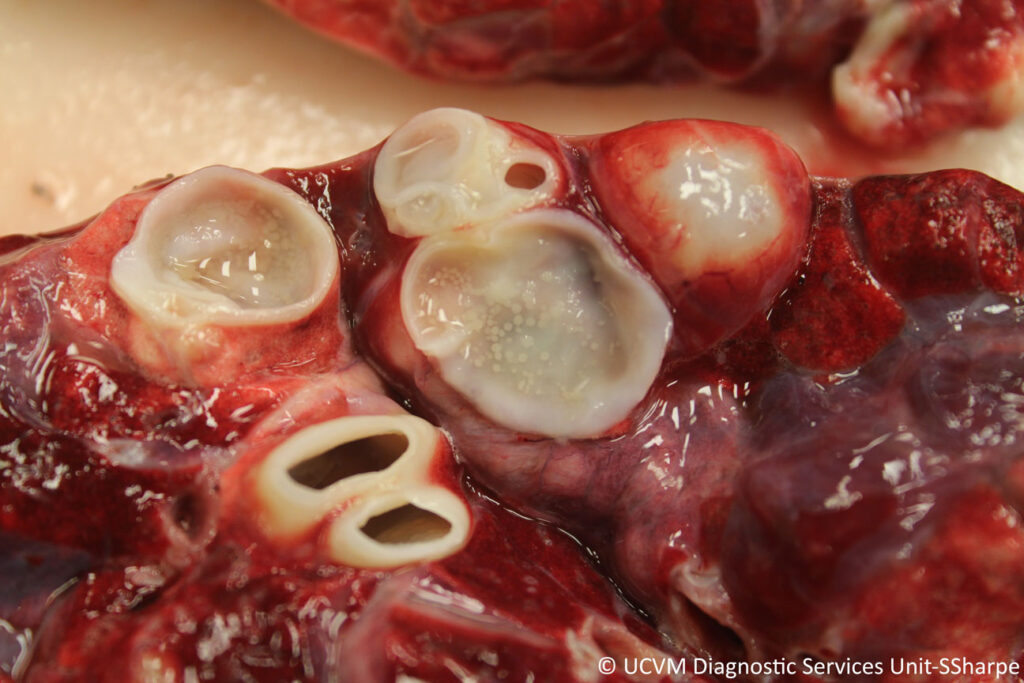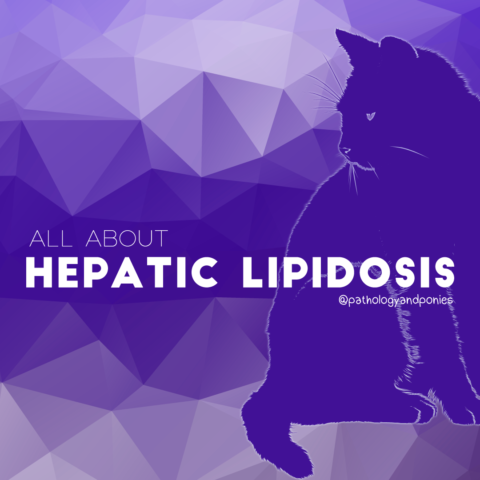Today’s path rounds are on 𝐄𝐜𝐡𝐢𝐧𝐨𝐜𝐨𝐜𝐜𝐨𝐬𝐢𝐬!
𝐖𝐡𝐚𝐭 𝐢𝐬 𝐢𝐭?
𝐄𝐜𝐡𝐢𝐧𝐨𝐜𝐨𝐜𝐜𝐨𝐬𝐢𝐬 is infection with either Echinococcus multilocularis or Echinococcus granulosus. These are species of 𝐭𝐚𝐩𝐞𝐰𝐨𝐫𝐦𝐬, little internal parasites that can have some serious consequences. Here in North America, E. multilocularis is the most important, and the one that we’ll be talking about today.
𝐖𝐡𝐨 𝐠𝐞𝐭𝐬 𝐢𝐭?
The primary species that E. multilocularis infects are foxes, coyotes and wolves. However, dogs, cats, or even people, who come in contact with infected animals may become infected themselves!
𝐇𝐨𝐰 𝐝𝐨 𝐚𝐧𝐢𝐦𝐚𝐥𝐬 𝐠𝐞𝐭 𝐢𝐧𝐟𝐞𝐜𝐭𝐞𝐝?
As mentioned before, the main hosts of this tapeworm are foxes, wolves and coyotes. In these animals, the adult worms reside in the intestine, and produce infective eggs which are passed in the feces. These eggs are ingested by 𝐢𝐧𝐭𝐞𝐫𝐦𝐞𝐝𝐢𝐚𝐭𝐞 𝐡𝐨𝐬𝐭𝐬 like mice or voles. Once inside an intermediate host, the egg hatches, travels through the intestinal wall, enters the liver and forms a 𝐡𝐲𝐝𝐚𝐭𝐢𝐝 𝐜𝐲𝐬𝐭, which is a big cyst that contains 𝐩𝐫𝐨𝐭𝐨𝐬𝐜𝐨𝐥𝐢𝐜𝐞𝐬. Protoscolices are basically the “head” of a new tapeworm. When the intermediate host is consumed by a fox, wolf or coyote, these protoscolices attach themselves to the intestinal wall of their new host, and develop into an adult tapeworm.
𝐖𝐡𝐲 𝐢𝐬 𝐭𝐡𝐢𝐬 𝐚 𝐩𝐫𝐨𝐛𝐥𝐞𝐦?
Many species can be 𝐚𝐛𝐞𝐫𝐫𝐚𝐧𝐭 𝐢𝐧𝐭𝐞𝐫𝐦𝐞𝐝𝐢𝐚𝐭𝐞 𝐡𝐨𝐬𝐭𝐬 (intermediate hosts that aren’t supposed to happen!). We most commonly see this in dogs and cats. These aberrant hosts develop similar hydatid cysts as seen in rodents, particularly in the liver and lungs. This can cause progressive abdominal enlargement, vomiting and inappetence. If a cyst ruptures, it can induce a severe 𝐚𝐧𝐚𝐩𝐡𝐲𝐥𝐚𝐜𝐭𝐢𝐜 𝐫𝐞𝐚𝐜𝐭𝐢𝐨𝐧, because the body simply has no idea where all this foreign material came from!
Another of these possible aberrant hosts is humans. Echinococcosis is a serious 𝐳𝐨𝐨𝐧𝐨𝐬𝐢𝐬 (animal disease that can infect humans). Often in humans, the only clinical sign is abdominal pain and possibly 𝐣𝐚𝐮𝐧𝐝𝐢𝐜𝐞 (yellowing of the tissues) indicating liver failure. Untreated infections have a very high fatality rate, so prompt diagnosis is critical!
𝐀𝐫𝐞𝐧’𝐭 𝐝𝐨𝐠𝐬 𝐢𝐧 𝐭𝐡𝐞 𝐬𝐚𝐦𝐞 𝐟𝐚𝐦𝐢𝐥𝐲 𝐚𝐬 𝐟𝐨𝐱𝐞𝐬, 𝐰𝐨𝐥𝐯𝐞𝐬 𝐚𝐧𝐝 𝐜𝐨𝐲𝐨𝐭𝐞𝐬? 𝐖𝐡𝐲 𝐚𝐫𝐞 𝐭𝐡𝐞𝐲 𝐚𝐛𝐞𝐫𝐫𝐚𝐧𝐭 𝐡𝐨𝐬𝐭𝐬?
One weird thing about dogs is that they can actually act as either a primary host, like a fox or wolf, and an aberrant host. It’s technically possible for this to even occur in the same animal, where the animal would have adults producing eggs and hydatid cysts at the same time. Weird!
𝐇𝐨𝐰 𝐢𝐬 𝐢𝐭 𝐝𝐢𝐚𝐠𝐧𝐨𝐬𝐞𝐝?
In our “domestic” patients (humans included), usually an ultrasound or X-ray is a good starting point to identify the large cysts in the liver. From there, a sample of the cyst fluid can be taken to visualize the protoscolices under a microscope, confirming the diagnosis.
𝐇𝐨𝐰 𝐢𝐬 𝐢𝐭 𝐭𝐫𝐞𝐚𝐭𝐞𝐝?
Typically, depending on the size and location of the cysts, surgical removal of the cysts is the main treatment. This is usually paired with administration of 𝐚𝐥𝐛𝐞𝐧𝐝𝐚𝐳𝐨𝐥𝐞, a potent anti-parasitic medication. However, hydatid cysts have a fairly impenetrable wall that makes it difficult for medication to enter where it is needed most. For this reason, human patients are often on albendazole for 2 years or more! Crazy.
𝐏𝐡𝐨𝐭𝐨𝐬
1) A liver showing hydatid cysts.
2) The same liver with a needle showing the contents of the cyst. This is called 𝐡𝐲𝐝𝐚𝐭𝐢𝐝 𝐬𝐚𝐧𝐝, and contains the protoscolices!
3) Hydatid cysts in the lung of a moose.
4) Protoscolices from a hydatid cyst, as seen under the microscope!
𝐒𝐨𝐮𝐫𝐜𝐞𝐬
Maxie, G. Jubb, Kennedy and Palmer’s Pathology of Domestic Animals, Volume 2. Sixth Edition.
Pearson, R.D. Echinococcosis. Merck Manual, 2020.
Photos 1-4 courtesy of University of Calgary Diagnostic Services Unit.








